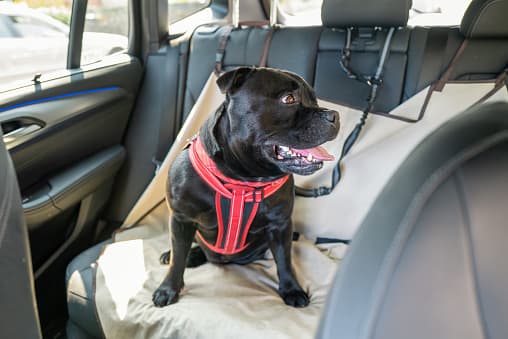How To Travel Safely With A Dog In The Car
Driving With Your Best Friend

Ireland certainly is a dog-loving nation. Did you know that in 2018, around 450,000 dogs were kept as pets in Ireland? These animals can quickly develop into an additional family member and become involved in activities and days out. Whether you frequently drive to the beach for a scenic dog walk or you take the dog on family picnics and other gatherings, it’s imperative that you’re travelling safely while your pet is in the car.
Below, you can find out how to safely travel with a dog so you can continue to make the most of your days out.
Can a passenger hold a dog in the car?
When travelling with a pet, it is not safe to get a passenger to hold them, no matter the size of the dog or the length of the journey. This is because there’s a chance they’ll wriggle out of reach and could become a distraction, putting you and other passengers at risk. Regardless if you have a small dog, like a chihuahua, or a large dog, such as a great dane, you should never leave an animal loose in a vehicle. They cannot be placed on someone’s lap or carried in a passenger’s arms.
How to strap a dog into a car
There are a few ways to ensure that your dog is properly restrained. These include using a harness or carrier or installing a metal guard.
With a harness
Using a harness is probably the easiest and cheapest option. The harness can be put on your dog and should go through their legs so it fits around their chest and neck. It should click together using the clasp. Once the harness is on your pet, use a clip to secure the harness to the car’s seat belt. Some harnesses actually clip into the seat belt slot too. It’s likely that this method will be most comfortable for your dog and allows some form of flexibility regarding where to put them (front seat, back seat, etc.). Harnesses can cost around €10, making them the most cost-effective option.When the harness is on, the dog shouldn’t be able to reach the driver. If they can, the lead that connects the harness to the seatbelt will need to be shortened, or the dog should be moved to another position. However, the lead should be long enough to allow some movement, such as standing, sitting and lying down.
With a pet carrier
For small breeds, a pet carrier might be a good idea. Generally, people associate carriers with cats, but they can be great for transporting smaller dogs too, such as pomeranians, Yorkshire terriers or dachshunds. However, this method may take your pet some time to become accustomed to. The carrier must be the right size for the dog and it will need to be secured with a seat belt. Most carriers have a handle on the top and the seat belt can be fed through this and clipped in.Your dog may need some carrier training before using it in the car for the first time. This can be done in your house by encouraging the dog to get into the carrier and giving them a treat when they do so. You want to avoid the carrier becoming a scary item for them. Once they’re comfortable using the carrier at home, you’re ready to use it in the car.
The carrier should not be placed in the boot of a saloon car because the airflow is restricted in this area and your pet may not get enough oxygen. You should also not leave the carrier unsecured in any area of the car. In the event of a car accident, the carrier can be thrown around, injuring passengers. The front or back seat is the best place for it. .
With a metal guard
Finally, you can use a metal guard that keeps the dog in the boot of the car, restricting their access to other passengers. These guards can be installed in most cars but work best in estates or large 4x4s. The purpose of these grids is to keep the passengers and driver safe in an accident.According to the Independent, if you were driving at 50km/h with a 25 kilogram dog and crashed, the dog would be thrown around the car with a force equivalent to more than 600kg, which could seriously injure anyone in the vehicle. Metal guards can prevent this from happening, however, what they don’t do so well is protect the dog itself. A dog will be kept safer when they’re strapped into a harness or contained in a carrier.
How to keep your dog calm in the car
Some pets are extremely nervous travellers, particularly if they associate car drives with the vet, and this could be a distraction for the driver. Therefore, how can you keep your dog calm while you’re driving?
Stay calm yourself
If you’re panicked and in a rush and trying to desperately get your dog in the car, they’re likely to sense your anxiety. For dogs that are anxious when travelling, it’s important for you to stay calm and do things slowly. Move around the car, letting them sniff it, and then ask them to sit. Reward them with a treat when they do this. This teaches your dog that cars aren’t anything to be afraid of. Let them get used to the vehicle when it’s stationary.
Go on short journeys at first
If your dog is a nervous traveller, it might be best to stick to short journeys until they get used to the car, and avoid any trips to the vet, as this can bring about negative associations with the car.
If you do need to go to the vet, take them on a walk afterwards and reward them with treats so the whole experience isn’t negative.
Give them a travel buddy
If your partner or children have a good bond with the dog, allow them to sit with him or her during car journeys. The dog can be strapped into the backseat with a harness and someone can sit with them, reassuring them the whole time.
Learn where they’re most comfortable
Dogs, just like people, may have a certain preference for where to sit in the car. Some people get carsick in the backseat but not the front seat and it may be the same with your pet. Find the spot where they’re happiest. You may also want to try different methods of strapping them in. For instance, if you’ve always used a harness, they might feel safer in a carrier, or vice versa. Take the time to learn what your dog wants.

